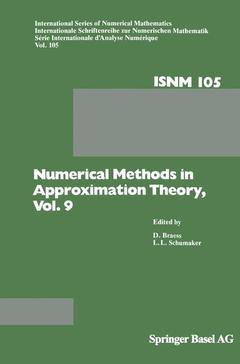Numerical Methods in Approximation Theory, Vol. 9, Softcover reprint of the original 1st ed. 1992 Coll. International Series of Numerical Mathematics, Vol. 105
Langue : Français
Coordonnateurs : Braess D., Schumaker L.L.

This book is the official proceedings of a conference on Numerical Methods in Approximation Theory which was held at the Mathematisches Forschungs institut in Oberwolfach during the week of November 24~30, 1991. It contains refereed and edited papers by 20 of the 49 participants. The book is dedicated to the memory of Prof. Lothar Collatz who main tained a long and active interest in numerical approximation. It is the ninth in a series of volumes published by Birkhiiuser resulting from conferences on the subject held at Oberwolfach, and co-organized by Prof. Collatz. We now briefly describe the contents of the book. The paper of BASZEN SKI, DELVOS and JESTER deals with blending using sine double series expan sions of functions defined on the unit square. In addition to giving explicit error estimates for partial sums and for interpolating sine polynomials, they also show that Boolean sums yield almost the same asymptotic error estimates as the conventional tensor-product approach, but with a reduced number of terms. The paper of BEATSON and LIGHT discusses approximation by quasi interpolants which are sums of scaled translates of a one-parameter family of functions. They do not require reproduction of low degree polynomials, but nevertheless are able to give error bounds and analyze quasi-interpolation based on Gaussians and exponentials. BINEV and JETTER deal with multivariate interpolation using shifts of a single basis function. They treat both gridded data and scattered data. As examples, they consider box splines and certain radial basis functions.
Blending Approximations with Sine Functions.- Quasi-interpolation in the Absence of Polynomial Reproduction.- Estimating the Condition Number for Multivariate Interpolation Problems.- Wavelets on a Bounded Interval.- Quasi-Kernel Polynomials and Convergence Results for Quasi-Minimal Residual Iterations.- Rate of Approximation of Weighted Derivatives by Linear Combinations of SMD Operators.- Approximation by Multivariate Splines: an Application of Boolean Methods.- Lm,?,s-Splines in ?d.- Constructive Multivariate Approximation via Sigmoidal Functions with Applications to Neural Networks.- Spline-Wavelets of Minimal Support.- Necessary Conditions for Local Best Chebyshev Approximations by Splines with Free Knots.- C1 Interpolation on Higher-Dimensional Analogs of the 4-Direction Mesh.- Tabulation of Thin Plate Splines on a Very Fine Two-Dimensional Grid.- The L2-Approximation Orders of Principal Shift-Invariant Spaces Generated by a Radial Basis Function.- A Multi-Parameter Method for Nonlinear Least-Squares Approximation.- Analog VLSI Networks.- Converse Theorems for Approximation on Discrete Sets II.- A Dual Method for Smoothing Histograms using Nonnegative C1-Splines.- Segment Approximation By Using Linear Functionals.- Construction of Monotone Extensions to Boundary Functions.
Date de parution : 10-2012
Ouvrage de 359 p.
15.5x23.5 cm
Disponible chez l'éditeur (délai d'approvisionnement : 15 jours).
Prix indicatif 52,74 €
Ajouter au panierMots-clés :
Invariant; addition; approximation; derivative; function; numerical method; theorem
© 2024 LAVOISIER S.A.S.



